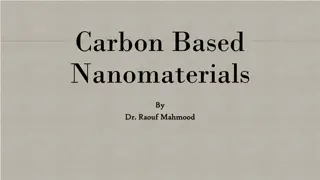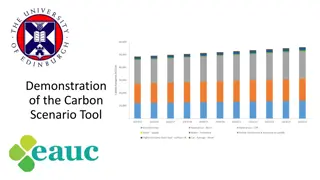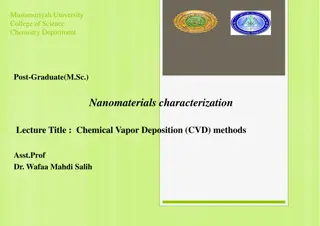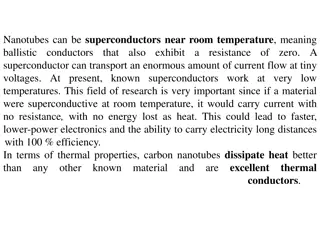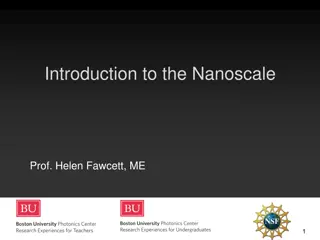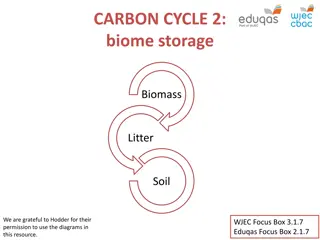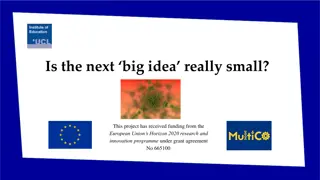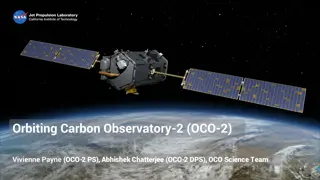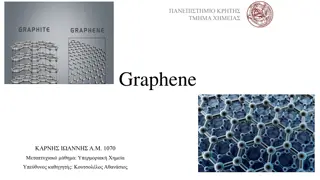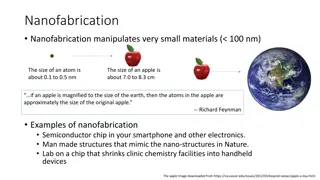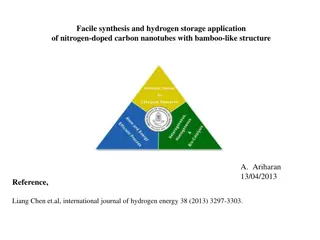Carbon Nanostructures: Fullerene, Carbon Nanotubes, Graphene Lecture
This lecture covers the unexpected discovery of buckminsterfullerene in 1985 by H.W. Kroto and his team, leading to a Nobel Prize in 1996. The presentation delves into the properties and significance of carbon nanostructures, including fullerenes, carbon nanotubes, and graphene. It also discusses the contributions of researchers such as R.E. Smalley and explores related concepts in physics and chemistry.
Download Presentation

Please find below an Image/Link to download the presentation.
The content on the website is provided AS IS for your information and personal use only. It may not be sold, licensed, or shared on other websites without obtaining consent from the author.If you encounter any issues during the download, it is possible that the publisher has removed the file from their server.
You are allowed to download the files provided on this website for personal or commercial use, subject to the condition that they are used lawfully. All files are the property of their respective owners.
The content on the website is provided AS IS for your information and personal use only. It may not be sold, licensed, or shared on other websites without obtaining consent from the author.
E N D
Presentation Transcript
CARBON NANOSTRUCTURES (FULLERENES, CARBON NANOTUBES, GRAPHENE) lecture for physics and chemistry students (2018. summer semester 02. March) Prof. Jen K rti ELTE Department of Biological Physics e-mail: kurti@virag.elte.hu www: virag.elte.hu/kurti
UNEXPECTED DISCOVERY in 1985 H.W.Kroto, J.R.Heath, S.C.O Brien, R.F.Curl, R.E.Smalley, C60: Buckminsterfullerene , Nature 318, 162 (14 Nov. 1985) NOBEL-PRIZE: in 1996
E.A.Rohlfing, D.M.Cox, A.Kaldor, J.Chem.Phys. 81, 3322 (1984)
H.W.Kroto, J.R.Heath, S.C.OBrien, R.F.Curl, R.E.Smalley, C60: Buckminsterfullerene , Nature 318, 162 (14 Nov. 1985) E.A.Rohlfing, D.M.Cox, A.Kaldor, J.Chem.Phys. 81, 3322 (1984)
H.W.Kroto, J.R.Heath, S.C.OBrien, R.F.Curl, R.E.Smalley, C60: Buckminsterfullerene , Nature 318, 162 (14 Nov. 1985) Curl Heath O Brien Smalley Kroto
Icosahedron Truncated Icosahedron
R. Buckminster Fuller American architect (1895-1983) e.g. geodesic dome Montreal world exposition 1967
C60 buckminsterfullerene buckyball (ballene spherene soccerene carbosoccer ...) d 0,7 nm
ANTECEDENTS PREHISTORY ANTIQUE Babylon: Greek: 60 Platon 5 regular solids, including icosahedron Archimedes 13 archimedean solids, among which truncated icosahedron Archimedes (287(?) - 212 B.C.) Archimedes is believed to have conceived the thirteen "Archimedean solids", among which the truncated icosahedron is found.
MIDDLE AGES 1480, Piero della Francesca first known art of a truncated icosahedron 1498 or 1509, drawing from Leonardo da Vinci of a truncated icosahedron in Luca Paciolis book 1500, art from Albrecht D rer of an outstreched truncated icosahedron XVI. c., truncated icosahedron in renaissance paintings China, Ming dynasty (1368-1644), lions sculpt, with his paw on a truncated icosahedron Topkapi Sarayi, part of a truncated icosahedron above a gate Jap n kagome (triangle-hexagon) structures with pentagon (heptagon) substitution (fairy-lamp)
MIDDLE AGES 1480, Piero della Francesca az els ismert rajz a csonkolt ikoza derr l 1498 vagy 1509, Leonardo da Vinci rajza csonkolt ikoza derr l Luca Pacioli k nyv ben 1500, Albrecht D rer rajza egy kiter tett csonkolt ikoza derr l XVI. sz., renesz nsz festm nyeken csonkolt ikoza der K na, Ming dinasztia (1368-1644), oroszl nszobor, mancs val csonkolt ikoza deren Topkapi Sarayi, csonkolt ikoza der r szlet egy kapu f l tt Jap n kagome (h romsz g-hatsz g) szerkezetek tsz g (h tsz g) helyettes t ssel (lampion)
Piero della Francesca (1420-1492) This is oldest known picture of a truncated icosahedron (the shape of C60. It is from the book Libellus de quinque corpibus regularibus ("On the Five Regular Bodies"), by the Italian renaissance painter and mathematician Piero della Francesca.
Leonardo da Vinci (1452-1519) This rendition of the truncated icosahedron is from the book De Divina Proportione ("On Divine Proportion") by Fra' Luca Pacioli, published around 1498. The drawing is ascribed to Leonardo da Vinci. He seems to have invented this type of "skeleton model", which lets us view both the outside and the inside of the polyhedron. Johannes Kepler (1571-1630) The concept of truncating a polyhedron was introduced by Johannes Kepler. Polyhedra were actually quite central to his research. In his work Prodromus Dissertationum Mathematicarum Continens Mysterium Cosmographicum ("The Cosmographic Mystery") he argued that the distances of the planets from the sun were determined by the Platonic solids.
Fine Arts An example of the appearance of the truncated icosahedron in art is shown in this picture from an Italian cathedral. At the top we see an icosahedron. It is bounded by twenty equilateral triangles. At each of the 12 vertices of the icosahedron, five of the triangles meet. Cutting off ('truncating') these vertices thus replaces each of them by a pentagonal face; it also converts each of the twenty former triangular faces into a hexagon. We can see the resulting truncated icosahedron at the bottom of the picture. This is the shape of the C60 molecule.
XX. century 1933, L szl Tisza icosahedral point group 1942, D.W. Thompson: carbon cage of 12 pentagons + any number of hexagons 1965, Schultz, from geometrical considerations: C60H60 truncated icosahedron 1966, David Jones ( Daedalus ), in New Scientist: football shaped carbon molecule from hexagons (intermediate density) Buckminster Fuller (1895-1983), geodesic buildings 1970, Eiji Osawa, Kagaku-ban (Yoshida): possibility of 3D aromatic structures C60 ( 1971, W.E. Barth s R.O. Lawton, synthesis of corannulene) 1973, D.A. Boc var and G.E. Gal pern, generalizatoin of ferrocene structure C20 (suggestion of Stankevic : C60) 1980, S. Iijima, with electron microscope: spherical carbon particles from carbon evaporated in vacuum 1981, R.A. Davidson, H ckel calculations on carbon clusters, also on C60 1983, L.A. Paquette, C20H20 synthesis (dodecahedron) 1981-85, O. Chapman, tried to synthesize C60 without success 1985 september Kroto, Smalley, Curl, 1985 okt ber 9., A.D.J. Haymet, H ckel calculations on C60






